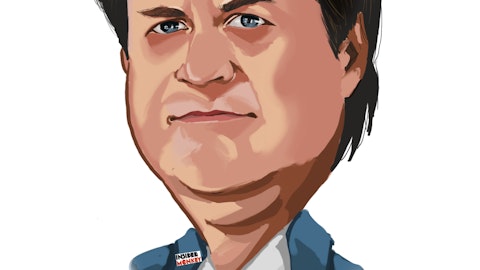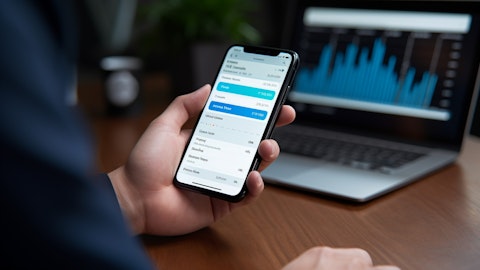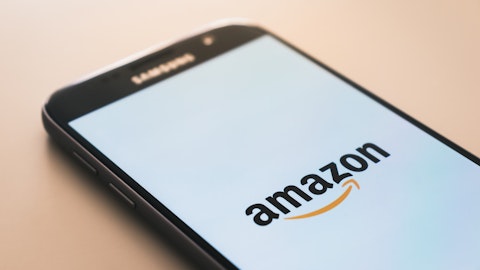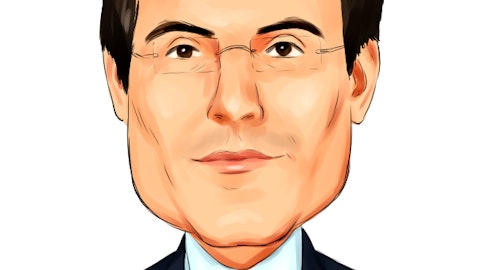Alphabet Inc. (NASDAQ:GOOG) Q4 2023 Earnings Call Transcript January 30, 2024
Alphabet Inc. beats earnings expectations. Reported EPS is $1.64, expectations were $1.6.
Operator: Welcome, everyone. Thank you for standing by for the Alphabet Fourth Quarter 2023 Earnings Conference Call. At this time, all participants are in a listen-only mode. After the speaker presentation, there will be a question-and-answer session. [Operator Instructions] I would now like to hand the conference over to your speaker today, Jim Friedland, Director of Investor Relations. Please go ahead.
Jim Friedland: Thank you. Good afternoon, everyone, and welcome to Alphabet’s fourth quarter 2023 earnings conference call. With us today are Sundar Pichai, Philipp Schindler, and Ruth Porat. Now, I’ll quickly cover the Safe Harbor. Some of the statements that we make today regarding our business, operations, and financial performance may be considered forward-looking. Such statements are based on current expectations and assumptions that are subject to a number of risks and uncertainties. Actual results could differ materially. Please refer to our Forms 10-K and 10-Q, including the risk factors discussed in our upcoming Form 10-K filing for the year ended December 31, 2023. We undertake no obligation to update any forward-looking statement.
During this call, we will present both GAAP and non-GAAP financial measures. A reconciliation of non-GAAP to GAAP measures is included in today’s earnings press release, which is distributed and available to the public through our Investor Relations website located at abc.xyz/investor. Our comments will be on year-over-year comparisons unless we state otherwise. And now, I’ll turn the call over to Sundar.
Sundar Pichai: Hello, everyone. Our results reflect strong momentum and product innovation continuing into 2024. Today, I’m going to talk about four main topics. One, our investments in AI, including how it’s helping search. Two, subscriptions which reached $15 billion in annual revenue, up 5x since 2019. Subscriptions is growing strongly, powered by YouTube Premium and Music, YouTube TV and Google One. Three, Cloud which crossed $9 billion in revenues this quarter and saw accelerated growth driven by our Gen AI and product leadership. And four, our investments and focus to meet the growth opportunities ahead. First, AI and Search. As you know, we have long led the way in using AI to improve many of our products from search to ads, to most of our consumer and enterprise products, helping billions of people already.
Last year brought new excitement around Gen AI and I’m proud of how we responded, responsibly with deep advances in foundation models and a number of great launches. We closed the year by launching the Gemini era, a new industry-leading series of models that will fuel the next generation of advances. Gemini is the first realization of the vision we had when we formed Google DeepMind, bringing together our two world-class research teams. It’s engineered to understand and combine text, images, audio, video and code in a natively multimodal way and it can run on everything from mobile devices to data centers. Gemini gives us a great foundation. It’s already demonstrating state-of-the-art capabilities and it’s only going to get better. Gemini Ultra is coming soon.
The team is already working on the next versions and bringing it to our products. That starts with Search. We’re already experimenting with Gemini in search where it’s making our Search Generative Experience or SGE faster for users. We have seen a 40% reduction in latency in English in the U.S. I’m happy with what we are seeing in the earliest days of SGE, it’s available through search labs in seven languages. By applying generative AI to Search, we are able to serve a wider range of information needs and answer new types of questions, including those that benefit from multiple perspectives. People are finding it particularly useful for more complex questions like comparisons or longer queries. It’s also helpful in areas where people are looking for deeper understanding such as education or even gift ideas.
We are improving satisfaction including answers for more conversational and intricate queries. As I mentioned earlier, we are surfacing more links with SGE and linking to a wider range of sources on the results page and will continue to prioritize approaches that add value for our users and send valuable traffic to publishers. Beyond SGE, we are continuing to use AI to make searching more accessible and intuitive. Circle to Search, lets you search what you see on Android phones with a simple gesture without switching apps. It’s available starting this week on Pixel 8 and Pixel 8 Pro and the new Samsung Galaxy S24 Series. And Lens now offers generative AI overviews. You can add text to a visual search to ask questions about anything you see and get AI-powered insights in the moment.
In addition to Search, we are also seeing a lot of interest in our AI-powered solutions for advertisers. That includes our new conversational experience that uses Gemini to accelerate the creation of search campaigns. Then there is Bard, our conversational AI tool that complements search. It’s now powered by Gemini Pro and is much more capable at things like understanding, summarizing, reasoning, coding and planning. It’s now in over 40 languages and over 230 countries around the world. Looking ahead, we’ll be rolling out an even more advanced version for subscribers powered by Gemini Ultra. That’s a good segue to subscriptions. As I said earlier, it’s now a $15 billion business annually. YouTube is the key driver of our subscription revenues.
Available in over 100 countries and regions, YouTube Music and Premium have real momentum. They’re engaging passionate users and driving great returns for the music industry and creators. YouTube TV is also doing well. We’ve had great consumer feedback on the viewing experience. People love the navigation, multi view and unlimited DVR. NFL Sunday Ticket has found it’s perfect home on YouTube and Philipp will talk about that more. Let me also talk about our subscription service, Google One. It’s doing incredibly well with strong user growth. It provides expanded storage, unlocks exclusive features in Google products and allows us to build a strong relationship with our most engaged users. Google One is growing very well and we are just about to cross 100 million subscribers.
From here, we are going to bring in more AI features and look forward to more strong growth to come. Next, Google Cloud. Throughout 2023, we introduced thousands of product advances, including broad Gen AI capabilities across our AI infrastructure, our Vertex AI platform and our new Duvet AI agents. In Q4, our product and Gen AI leadership enabled us to win and expand relationships with many leading brands including Hugging Face, McDonald’s, Motorola Mobility and Verizon. Google Cloud offers our AI Hypercomputer, a groundbreaking supercomputing architecture that combines our powerful TPUs and GPUs, AI software and multi-slice and multi-host technology to provide performance and cost advantages for training and serving models. Customers like Anthropic, Character AI, Essential AI and Mistral AI are building and serving models on it.
For developers building Gen AI applications, we offer Vertex AI, a comprehensive enterprise AI platform. It helps customers like Deutsche Telekom and Moody’s discover, customize, augment and deploy over 130 Gen AI models, including PaLM, Med-PaLM, Sec-PaLM and Gemini, as well as popular open source and partner models. Vertex AI has seen strong adoption with the API request increasing nearly 6x from H1 to H2 last year. Using Vertex AI, Samsung recently announced its Galaxy S24 Series smartphone with Gemini and Imagen 2, our advanced text-to-image model. Shutterstock has added Imagen 2 to their AI image generator, enabling users to turn simple text prompts into unique visuals and Victoria’s Secret & Company will look to personalize and improve the customer experience with Gemini, Vertex AI search and conversations.
Customers are increasingly choosing Duvet AI, our packaged AI agents for Google Workspace and Google Cloud Platform to boost productivity and improve their operations. Since its launch, thousands of companies and more than a million trusted testers have used Duvet AI. It will incorporate Gemini soon. In Workspace, Duvet AI is helping employees benefit from improved productivity and creativity at thousands of paying customers around the world, including Singapore Post, Uber and Woolworths. In Google Cloud Platform, Duvet AI assist software developers and cybersecurity analysis. Duvet AI for developers is the only Gen AI offering to support the company development and operations lifecycle, fine-tune with the customers’ own core corpus and policies.
It’s helping Wayfair, GE Appliances and Commerzbank write better software, faster with AI code completion, code generation and chat support. With Duvet AI and security operations, we are helping cybersecurity teams at Fiserv, Spotify and Pfizer. Our robust growth has been driven by strong direct and indirect channels. With ISVs, we have nearly tripled the number of co-sell deals from 2022 to 2023. In our ecosystem, there are nearly 90,000 Google Cloud Gen AI-enabled consultants. And Accenture has teamed up with Google Cloud to create a joint generative AI center of excellence. Next, let me turn to our focus and discipline as we pursue the opportunities ahead. Search, YouTube and Cloud are supported by our state-of-the-art compute infrastructure.
This infrastructure is also key to realizing our big AI ambitions. It’s a major differentiator for us. We continue to invest responsibly in our data centers and compute to support this new wave of growth in AI-powered services for us and for our customers. Through this, we are being disciplined in how we run the company. You’ve heard me talk about our efforts to durably reengineer our cost base and to improve our velocity and efficiency. That work continues. Teams are working to focus on key priorities and execute fast, removing layers and simplifying their organizational structures. As just one example, our devices team has brought together different teams from across Nest, Fitbit and other teams into a new functional structure. This will help us pull resources and drive progress across our Pixel portfolio.
Across different teams, we have wound down some non-priority projects, which will help us invest and operate well in our growth areas. We are also improving our machine utilization, building on our years of experience in driving cost efficiencies in our computing infrastructure and operations. And through our supplier efficiency efforts and automation of certain processes, we have made major improvements in areas like procurement, achieving significant savings. That’s a snapshot of the quarter. Before I close, a couple of other highlights. Pixel 8, our AI-first phone, was awarded Phone of the Year by numerous outlets. It now uses Gemini Nano with features like Magic Compose for Google Messages and more to come. In our Other Bets portfolio of companies, Waymo, which is deeply focused on safety, reached over 1 million fully autonomous ride-hailing trips.
And Isomorphic Labs entered into strategic partnerships with Eli Lilly and Novartis to apply AI to treat diseases, which has great potential. 2023 was a year of profound innovation and product momentum. Thank you to our many partners. We succeed when our partners do, and we are grateful for the work we do together, from our partners across the Android ecosystem who are on display at CES to our deep relationships with retailers, small businesses and advertising partners, to the next generation of AI start-ups and developers and many more. I also want to thank all of our employees for their hard work throughout 2023 and the start of the new year. I’m excited for what’s ahead in 2024. Philipp?
Philipp Schindler: Thanks, Sundar, and hi, everyone. Google Services revenues of $76 billion were up 12% year-on-year. In Google advertising, Search and other revenues grew 13% year-on-year, led again by solid growth in the retail vertical. We had particular strength in retail in APAC, a trend that began in the second quarter of 2023 and continued through the end of the year. YouTube ads revenue were up 16% year-on-year, driven by growth in both direct response and brand. And network revenues declined 2% year-on-year. In Subscriptions, Platforms and Devices, which was previously named Google Other, year-on-year revenues increased 23% driven by strong growth in subscriptions. Now for some color on the quarter and where we see continued upside for long-term advertising growth.
Over the last few calls, I have consistently highlighted how we’re putting Google AI to work for our customers to deliver profitability and help them achieve their goals in a do-more-with-less environment. From a product perspective, in Q4, Performance Max remained a bright spot. We’re also excited about [demand gen] momentum. This is our big bet to help social advertisers find and convert consumers via immersive, relevant visual creatives across YouTube, including YouTube Shorts, Gmail and Discover. In a single campaign, you get access to over three billion users as they stream, scroll, connect and decide what to buy. Tens of thousands of advertisers are testing and on average seeing 6% more conversions per dollar versus image-only ads and discovery campaigns.

As we look ahead, we’re also starting to put generative AI in the hands of more and more businesses to help them build better campaigns and even better performing ads. Automatically created assets help advertisers show more relevant search ads by creating tailored headlines and descriptions based on each ads’ context. Adoption was up with strong feedback in Q4. In addition to now being available in eight languages, more advanced Gen AI-powered capabilities are coming to ACA. And then last week’s big news was that Gemini will power a new conversational experience in Google Ads. This is open in beta to U.S. and UK advertisers. Early tests show advertisers are building higher-quality search campaigns with less effort, especially SMBs who are 42% more likely to publish a campaign with good or excellent ad strength.
We can’t wait to see how this continues to drive performance and level the playing field for advertisers of all sizes. As we shared last quarter, ads will continue to play an important role in the new search experience, and we’ll continue to experiment with new formats native to SGE. SGE is creating new opportunities for us to improve commercial journeys for people by showing relevant ads alongside search results. We’ve also found that people are finding ads either above or below the AI-powered overview helpful as they provide useful options for people to take action and connect with businesses. Looking at our strong Search performance for the fourth quarter. Retail was a highlight. We continue to see a stronger start to the season up to and including Cyber Five.
In Q3, we indicated that we were seeing early trends of consumers being very price-conscious, and we saw this play out in Q4. With promotional demand at an all-time high, deal seekers using Google had access to 2x the deals in the U.S. versus last season as well as a better shopping experience. Launches included a one-stop shop deals destination, new filters like GetItFast and AI-generated gifting recommendations in SGE. These new features drove incremental query growth during key shopping moments like Cyber Five. Our proven AI-powered ad solutions were also a win for retailers looking to accelerate omni growth and capture holiday demand. Quick examples include a large U.S. big-box retailer who drove a 60%-plus increase in omni ROAS and a 22%-plus increase in store traffic using Performance Max during Cyber-Five; and a well-known global fashion brand, who drove a 15%-plus higher omnichannel conversion rate versus regular shopping traffic by showcasing its store pickup offering across top markets through pickup later on shopping ads.
Moving on to YouTube. We’re obviously pleased with YouTube’s advertising revenue growth in Q4 and also significant growth in our subscription revenue. I’ll reiterate what I have said before. YouTube success starts with creator success. We give millions of creators more ways to create content and connect with fans and more ways to make money and build their own businesses than any other platform. More creators means more content, which leads to more viewers. And via ads and subscriptions, these viewers fund our creators and drive the eyeballs and engagement our advertisers want. To keep this momentum going, we’re focused on delivering value across four pillars: creation, viewers, monetization and responsibility. First, creation, which increasingly takes place on mobile devices.
We’ve invested in a full suite of tools, including our new YouTube Create app for Shorts, to help people make everything from 15-second Shorts to 15-minute videos to 15-hour live streams with a production studio in the palm of their hands. Gen AI is supercharging these capabilities. Anyone with a phone can swap in a new backdrop, remove background extras, translate their video into dozens of languages, all without a big studio budget. We’re excited about our first products in this area from Dream Screen for AI-generated backgrounds to allowed for AI-powered dubbing. There is more to come. Number two, viewers. We continue to grow watch time across YouTube with strong growth in Shorts and Connected TV. Shorts remains a top priority. We have 2 billion-plus logged-in users every month, and we are averaging 70 billion in daily views.
Connected TVs or what we refer to as the living room is where viewership is growing the fastest. We’re investing to make this experience even better with interactive features tailored to TVs, plus the content people love: our creators, NFL Sunday Ticket and the range of live sports and studio content via YouTube TV and Primetime Channels. Put this all together, and YouTube is the must-have app on every Connected TV. Monetization is pillar number three and realized through a combination of ad-supported and subscription offerings. Advertising generates the bulk of our revenue, and we continue to invest heavily here. We’ve rolled out CTV-first formats like 30-second non-skippable ads and pause experiences as well as an industry-first send-to-phone experience that lets people use a second screen to engage with ads.
For Shorts, we’ve developed new formats that are less interruptive to viewers. It’s early. We’re learning but excited by the opportunities for ads this can unlock. Shorts monetization continues to progress nicely. Our AI part video format from video reach and video view campaigns to demand gen and video action continue to make advertiser dollars go further and drive results across the funnel. We’re also introducing new and existing advertisers to YouTube via sports content. 90-plus upfront and scatter advertisers, including Unilever, are partnering with YouTube in our first year across NFL Sunday Ticket in-game advertising opportunities. Our subscription offerings are also growing at a healthy clip. YouTube Music and Premium performed well.
Premium users are delivering more value to our partners and YouTube than even ad-supported users do. On average, each additional Premium sign-up boost earnings for creators, music and media partners and YouTube itself. And we’ve made Premium even more attractive with new features, bundles and other enhancements. We’re also pleased with our first season of NFL Sunday Ticket. It gave creators new opportunities to create content and feed user engagement across traditional user content and professional sports content. Feedback on the user experience, including MultiView, has been great. We’re excited to continue to innovate here. Responsibility is our fourth pillar, and it underlines everything we do across YouTube. We continue to focus relentlessly on this.
As always, deepening our relationships with key partners to bring them the best of Google is a key priority for us, and we continue to do this across industries in Q4. We just talked about the NFL. Sundar mentioned Samsung, among others earlier. Another highlight was our expanded partnership with Porsche to enhance customers’ digital experiences with a deeper in-vehicle integration of Google built-in services, including Google Maps and Play. Whether it’s continued collaboration with our partners and key ecosystems, we’re putting Google AI to work for more customers. I’m excited about the opportunities for continued impact in 2024. I’ll wrap with a huge note of gratitude to our customers and partners. Our success is only possible because of their success and then to our Googlers for their outstanding work and focus this year.
Ruth, over to you.
Ruth Porat: Thank you, Philipp. We are very pleased with our full year results with 2023 Alphabet revenues of $307 billion, up 9% versus 2022, which added $25 billion to revenues for the year. We ended with a strong fourth quarter with consolidated revenues of $86.3 billion, up 13% versus last year in both reported and constant currency. Search remained the largest contributor to revenue growth. My comments will be on year-over-year comparisons for the fourth quarter, unless I state otherwise. Total cost of revenues was $37.6 billion, up 6%. Other cost of revenues was $23.6 billion, up 5%, with the increase driven primarily by content acquisition costs associated with YouTube subscription offerings. The growth rate also reflects the offsetting benefit of lapping $1.2 billion in inventory-related charges that we called out in the fourth quarter last year as well as a reduction in depreciation expense due to changes in estimated useful lives we made starting in the first quarter of 2023.
In terms of total expenses, the year-on-year comparisons reflect an additional $1.2 billion in exit charges that we took in the fourth quarter of 2023 in connection with actions to optimize our global office space. As you can see in our earnings release, these charges were allocated across the expense lines in other cost of revenues and OpEx based on associated headcount. Operating expenses were $25 billion, up 11%, primarily reflecting an increase in R&D expenses, which were driven by the real estate charges, followed by compensation. Operating income was $23.7 billion, up 30%, and our operating margin was 27%. Net income was $20.7 billion, and EPS was $1.64. We delivered free cash flow of $7.9 billion, which was affected by the timing of the $10.5 billion tax payment we made on October 16 that we called out previously related to the deferral of certain tax payments to the fourth quarter.
For the full-year 2023, free cash flow was $69 billion. We repurchased a total of $62 billion of our Class A and Class C shares in 2023 and ended the year with $111 billion in cash and marketable securities. Turning to segment results. Within Google Services, revenues were $76.3 billion, up 12%. Google Search and other advertising revenues of $48 billion in the quarter were up 13%, led again by growth in retail. YouTube advertising revenues of $9.2 billion were up 16% driven by both direct response and brand advertising. Network advertising revenues of $8.3 billion were down 2%. Subscriptions, Platforms and Devices revenues, which we previously referred to as other revenues, were $10.8 billion, up 23%, primarily reflecting growth in YouTube subscription revenues.
TAC was $14 billion, up 8%. Google Services operating income was $26.7 billion, up 32%, and the operating margin was 35%. Turning to the Google Cloud segment. Revenues were $9.2 billion for the quarter, up 26%. We’re very pleased with the momentum of GCP with an increasing contribution from AI. Google Workspace also delivered strong revenue growth, primarily driven by increases in average revenue per seat. Google Cloud delivered operating income of $864 million and an operating margin of 9%. As to our Other Bets, for the full-year 2023, revenues were $1.5 billion, and the operating loss was $4.1 billion. Results in the fourth quarter benefited from a milestone payment in one of the Other Bets. Turning to our outlook for the business. With respect to Google Services, first, within advertising.
We were pleased with the sequential revenue growth of Search and YouTube advertising throughout 2023, which reflects the extraordinary work across our teams to drive improved experiences for users and attractive ROI for advertisers. As we enter 2024 with advertising revenues of more than $100 billion higher than 2019, we remain focused on sustaining healthy growth on this larger base. Second, within Subscriptions, Platforms and Devices, our total revenues from subscription products reached $15 billion for the full-year 2023, driven primarily by substantial growth in subscribers for our YouTube subscription offerings. The substantial increase in our subscription revenues over the past few years demonstrates the ability of our teams to deliver high value-add offerings and provides a strong base on which to build, including through YouTube and newer services like Google One.
Play had solid growth again in the fourth quarter, driven primarily by an increase in the number of buyers. In Devices, we continue to make sizable investments with increased emphasis on our Pixel family, particularly with AI-powered innovation while driving further efficiencies across the portfolio. Turning to Google Cloud. We are pleased with operating performance in the year. Full year revenues of $33 billion were up 26% versus prior year, ending with strong Q4 performance. The Cloud team is intensely focused on bringing the benefits of Gemini, our industry-leading AI technology, to enterprises and governments globally, and we are gratified with the level of engagement. The strong demand we are seeing for our vertically integrated AI portfolio is creating new opportunities for Google Cloud across every product area.
In terms of profitability, the improvement in 2023 reflects sustained focus across the team with the intent to maintain healthy profitability while we continue to invest to support long-term growth. Turning to margins and expenses. As we have repeatedly stressed, we remain committed to our framework to durably reengineer our cost base as we invest to support our growth priorities. Key contributors to moderating our expense growth include: first, product and process prioritization to ensure we have the right resources behind our most important opportunities and to reallocate resources where we can; second, organizational efficiency and structure. We’re focused on removing layers to simplify execution and drive velocity. Both product prioritization and the organization design efforts result in a slower pace of hiring, as you can see with our headcount down year-on-year, reflecting the reductions we announced in the first quarter of 2023 and a much slower pace of hiring.
We will continue to invest in top technical and engineering talent. Finally, we continue to execute the other work streams to slow expense growth, including improving efficiency in our technical infrastructure, streamlining operations across Alphabet through the use of AI, increasing efficiency of our spend with suppliers and vendors through our central procurement organization, and optimizing our real estate portfolio. With respect to CapEx, our reported CapEx in the fourth quarter was $11 billion, driven overwhelmingly by investment in our technical infrastructure with the largest component for servers followed by data centers. The step-up in CapEx in Q4 reflects our outlook for the extraordinary applications of AI to deliver for users, advertisers, developers, cloud enterprise customers and governments globally and the long-term growth opportunities that offers.
In 2024, we expect investment in CapEx will be notably larger than in 2023. With regard to Other Bets, we’ve been working to sharpen our investment focus while capturing the upside given compelling technology breakthroughs across the portfolio. For example, last week, Alphabet’s X announced that it would be moving to spin out more projects as independent companies through external capital, giving X the opportunity to bring more focus to the breakthrough technologies it is working on to address some of the world’s most pressing challenges. Thank you. Sundar, Philipp and I will now take your questions.
See also 15 Cheapest Countries to Get Permanent Residency Heading into 2024 and Here is How Billionaire Chris Hohn’s Hedge Fund Beat the Market with 33% Gain.
Q&A Session
Follow Alphabet Inc. (NASDAQ:GOOG)
Follow Alphabet Inc. (NASDAQ:GOOG)
Operator: [Operator Instructions] And our first question comes from Brian Nowak with Morgan Stanley.
Brian Nowak : I have two for Philipp. Philipp, the first one is about sort of a lot of the new generative AI advertising tools. You obviously have a lot of irons in the fire here. You’ve been talking about some of the early momentum with tens of thousands of advertisers. The question is, can you sort of walk us through some of the hurdles and gating factors that we should be thinking through that dictate the pace at which these tools can really be rolled out broadly just so we and advertisers can kind of get an understanding for when they could have a bigger impact on the whole business? And then secondly, how do you think about the long-term sales force intensity of the advertising business as you roll more AI-based tools like PMax impacting the overall ad allocation?
Philipp Schindler: Yes. Thank you so much. So I’ve covered this a little bit on previous quarters. AI has been at the core of our advertising products for a very, very long time. And the recent advances are really allowing us to drive more value for advertisers across a large range of different areas: bidding, targeting, creative as well as our core advertiser and publisher experiences. We are seeing in core search ads, for example, the bidding side, the value-based bidding as a very significant one on the targeting side, the broad match on creative, responsive search ads automatically created ads assets. And we are very happy with the progress we’re seeing in those areas. I think I mentioned in one of the previous calls that one.
You asked about hurdles and gating factors. The AI essentials play neutral in this trying to get everybody ready to really take full advantage of those tools. We talked about the progress on PMax as well that we’re very happy with in Q4. So overall, I think we are on track with what we’re expecting here. On the sales force intensity side, we have done a few reallocations or let me call it portfolio adjustments. As you know, we have two large different teams. One is our LCS, Large Customer Solutions team that’s really focused on transformational growth for our largest and most sophisticated customers. And we have our — we call them GCS, Global Customer Solutions, team, which is the channel where really every customer starts from some of our largest customers now to also the millions of smaller ones and SMBs. The GCS is really then scaling growth by dynamically delivering really the right treatment for every customer.
And important to note, it’s also our fastest-growing channel, and it delivered particularly strong growth in Q4. So we have done adjustments here to focus more resources on the GCS side. But I also want to be clear, when we restructure, there’s always an opportunity to be more efficient and smarter in how we service and grow our customers. We’re not restructuring because AI is taking away roles that’s important here. But we see significant opportunities here with our AI-powered solution to actually deliver incredible ROI at scale, and that’s why we’re doing some of those adjustments. So I look at sales force intensity as a stronger focus going forward on the channels I mentioned here.
Operator: Our next question comes from Doug Anmuth with JPMorgan.
Doug Anmuth : One for Ruth and one for Philipp. Ruth, you’re now into year two of durably reengineering your cost structure. Can you just help us assess your progress so far? And are there any guideposts that we should be thinking about going forward? And then, Philipp, can you talk more about NFL Sunday Ticket and just what your key learnings were in year one? How are you thinking about the returns on the investment on both from an advertising perspective and then also subscribers to both Sunday Ticket and YouTube TV?
Ruth Porat: Thanks for the question. So we are very pleased with the progress we’re continuing to make, and we are very committed to the framework to durably reengineer our cost base really as we’re investing to support the growth priorities. I tried to call out a number of them in opening comments, but really, as you’re looking at the work being done across Google, across Alphabet, it does start with product and process prioritization to make sure we’ve got the right resources behind the most important opportunities, and then that creates the opportunity for reallocating resources where we can. Then we talked a lot about this quarter about organizational efficiency and structure, and we’re focused on removing layers to simplify execution and drive velocity.
The combination of those two, product prioritization and organizational design work, has resulted in the slower pace of hiring. You can see that in our headcount numbers down year-on-year. You can see it in some of the — in the results that we delivered in the fourth quarter. You can — and it also goes to the announcements around first quarter and much lower pace of hiring. At this point in the quarter, we do estimate that severance-related expense will be roughly $700 million in the first quarter as we’ve continued these efforts. But as I said in opening comments, we will continue to invest in top engineering. So that’s sort of the big one, if you start with product prioritization and organizational design, which is why also the note about the severance-related expense, which helps pave the way as we’re continuing to do the work that we’re doing.





